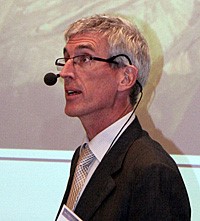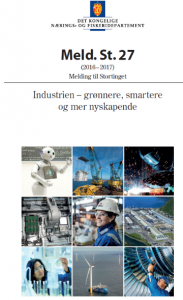
An important component of the Interreg Process-SME project is to gather input on future technological developments and challenges, to give input to forming of EU financing programmes, says Ross Wakelin from Northern Research Institute Norut AS. Do you think that technology developments do not impact your company’s future? Some recent events and news items highlight ways information technology can have a greater than expected role, states Research Director Ross Wakelin.
There have been many examples of companies and experts underestimating the pace of technological developments. Some classic examples:
- The Industrial Revolution caught by surprise many manufacturers based on manual processes.
- John Henry Pepper, Scientist 1870: “Don’t sell your gas company shares, electric light has no future”.
- Thomas Watson, chairman of IBM, 1943: “I think there is a world market for maybe five computers”.
- Popular Mechanics, 1949: “Computers in the future may weigh no more than 1,5 tonnes”.
- Editor, Prentice-Hall business books, 1957: “… I can assure you that data processing is a fad that won’t last out the year”.
- Ken Olson, President of DEC, 1977: “There is no reason anyone would want a computer in their home”.
- Bill Gates, Microsoft founder, 2004: “Two years from now, spam will be solved”.
And other ones here: http://www.telegraph.co.uk/technology/0/worst-tech-predictions-of-all-time/

Research Director Ross Wakelin
Process-SME project aims to the future
While we can laugh at some of these statements, it shows it can be difficult to predict the pace and extent of technological developments. We see already that information technologies have replaced older technologies and made more information available, and faster. In the process industry, cheaper and faster sensors are giving new opportunities for control and optimisation of production processes. During the Interreg Process-SME project we want to gather input from the process industry and their suppliers on what technological developments and challenges they see for the future. The inputs will be summarised in an update of the Process-IT.EU Roadmap, which has been used for forming the priorities for EU industrial financing programmes. If you have some thoughts on this we would like to hear them! The previous version of the Process-IT.EU Roadmap can be downloaded here.
Technological developments can be pushed from the developers or pulled from the users, so both the process industry, and their suppliers can be sources for ideas on developments. Suppliers are taking a greater responsibility for parts of the process industry, requiring development of different business models to regulate the responsibility and remuneration. This is another part of the Interreg Process-SME project. With data processing components getting smaller and faster there are opening new opportunities for sensing and process control. This is giving rise to the term “Internet of Things” (IoT), where computing devices are embedded in everyday objects, enabling them to send and receive data, and modify operation. It is expected that this will result in a second Information Revolution, with opportunities for the process industry and their suppliers. Two challenges come to mind: a) how to manage and utilise all of the information generated, and b) how to ensure integrity and security of the system.
'Wannacry' ransomware
The recent “Wannacry” ransomware attack highlights a risk associated with increasing utilisation of information technology in processes. It will also be necessary to give increased attention to cyber security. This topic will be returned in later blog posts, with upcoming meetings to take information from such as the Cloud Security Alliance Nordic summit, 12-14 June 2017 in Stockholm and Nordic IT Security, 7 Nov 2017 in Stockholm. An overview of the vulnerability of the IoT to cyber attacks is given in this blog post. For more details John Lindström is a good person to contact within the Interreg Process-SME project.
Security challenges of toys
An interesting illustration of the security challenges posed by the IoT was provided at a conference of cyber security experts. A presentation was given by Reuben Paul, an 11-year-old boy, who hacked into Bluetooth devices of the audience and could use these devices to ‘weaponise’ his teddy bear, which had a Bluetooth connection to the cloud.

Weaponized Teddies
He showed how he could hack into the bear via the hijacked devices in the audience to turn on lights in the bear and record a message from the audience. He then went on to highlight other, more serious ways the security hole could be exploited as the IoT expands. Although only 11 years old the boy was already well-known in cyber security circles, and was already CEO of a software company when aged 8.
The increasing degree of automation and digitalisation has been projected to be a threat to future employment. Of course, some jobs will be replaced by technological developments, but other jobs will be created by new demands associated with the technologies. This may require other skills and education forms. Parents who are despairing of their children spending too much time on the computer could perhaps find some consolation in the case of Reuben Paul above. They might be developing just the kind of skills that will be needed in the future….
Alternative approach in mining company
Another approach to obtaining alternative skillsets for the process industry has been adopted by an Australian mining company . Facing a shortage of affordable mine workers during an expansion involving sourcing 1500 new workers they used some novel, targeted recruitment strategies. They find that the necessary skills can be learnt on the job, but instead seek abilities such as hand-eye coordination by targeting farm labourers or netball players, directing recruitment campaigns towards sporting arrangements.
 In Norway, the government has predicted that machines will increasingly replace humans in industry, resulting in routine work disappearing and there being fewer jobs that do not require special competence. In response, they proposed in a recent White Paper for Industry to increase financing for environmental technology, bio- and nanotechnology and information & communication technologies (ICT). Increased support for test centres for demonstrations of new technologies and access to venture capital are also proposed.
In Norway, the government has predicted that machines will increasingly replace humans in industry, resulting in routine work disappearing and there being fewer jobs that do not require special competence. In response, they proposed in a recent White Paper for Industry to increase financing for environmental technology, bio- and nanotechnology and information & communication technologies (ICT). Increased support for test centres for demonstrations of new technologies and access to venture capital are also proposed.
The amount of information available is increasing and will likely require technological solutions to utilise the information efficiency and avoid information overload of humans. This involves aspects such as data mining, artificial intelligence and machine learning, which will be commented on in a later blog post…
More information:
Ross Wakelin, Northern Research Institute Narvik A.S., ross@tek.norut.no
Leif-Gunnar Hanssen, Forskningsparken i Narvik, leif@fpn.no





